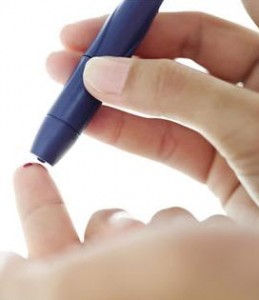 In the second of three articles about the real foods that raise your cholesterol (animal products are not among them!), we are going to look at sugar and review a form of sugar known as fructose. (If you missed the first article on trans fats, you can read it here.)
In the second of three articles about the real foods that raise your cholesterol (animal products are not among them!), we are going to look at sugar and review a form of sugar known as fructose. (If you missed the first article on trans fats, you can read it here.)
Studies have shown that it matters what form the sugar takes, what the sugar’s source is, and that not all sugars react the same way inside our bodies.
Glucose and Fructose
To help you understand the difference between glucose and fructose and more importantly, why it matters, I have to cover a little science. Bear with me and I’ll try to keep it simple and brief.
Glucose and fructose are two of the most common forms of sugar. They are both simple sugars and they have the same molecular form. But they have a different structure and as a result, they are metabolized very differently in the body.
One recent study followed participants for only 10 weeks. During the study, 25% of the participants’ energy requirements came from consuming either glucose or fructose sweetened beverages. The weight gain of both groups was comparable. But the group that consumed the fructose drinks gained measurably more intra abdominal fat, or the fat that forms around the organs in the abdomen. This fat has been shown to be a risk factor for many chronic illnesses including heart disease.
The fructose group also developed insulin resistance. In other words, they became less sensitive to insulin, the hormone whose job it is to control blood sugar levels through the release of glucose into the blood. Insulin resistance can lead to metabolic syndrome, which has been shown to increase the risk of heart attack among other things. And metabolic syndrome is the precursor to type II diabetes.
A number of studies have now revealed significant health differences between the consumption of glucose and fructose so let’s look at the differences.
Glucose
Glucose is the basis for all cellular energy. Since every cell in your body uses glucose, when you consume any glucose, your body utilizes it almost immediately. If you consume 120 calories of glucose, less than one calorie will be stored as fat because the rest essentially gets ‘burned up.’ Because it’s typically broken down in the cells, only a small amount of glucose will need to be broken down by the liver, the organ that performs carbohydrate metabolism and detoxification (among other roles.)
Fructose
As mentioned above, despite having the same molecular formula, fructose has a very different structure. As a result, they are metabolized very differently. Unlike glucose, which is metabolized in the body’s cells, fructose is metabolized completely by the liver just like ethanol — a known toxin — according to Dr. Robert Lustig, Professor at the University of California at San Francisco Medical School.
Metabolism in the liver also creates by products that pose health challenges, especially if the liver is working hard all day. Some of the by products include toxic waste and uric acid (which raises blood pressure and can lead to gout.)
Because our liver has so many important jobs, it can get overloaded and burn out; since we cannot live without it, the less burden we place on our livers, the better. Given the choice between glucose and fructose, it’s definitely better for our bodies to consume glucose, which can be processed predominantly in the cells of the body, over fructose since fructose taxes our livers.
In addition, there are several connections between fructose and fat. Remember that when we consume 120 calories of glucose only one is stored as fat. But when we consume 120 calories of fructose, 40 of those calories will be stored as fat! When it is metabolized, fructose is turned into free fatty acids, VLDL (the bad cholesterol), and triglycerides, which are stored in the body as fat.
The fatty acids also form fat droplets, which can accumulate in your liver and skeletal muscle tissues. These fat deposits can lead to non-alcoholic fatty liver disease and result in insulin resistance. Fructose is a carbohydrate that is metabolized in the body like a fat so no wonder it impacts our weight and our health so dramatically.
Fructose is not inherently bad. It is commonly found in the fruits and vegetables we’ve eaten for thousands of years. If we consume small amounts from fruits and vegetables throughout the day as our ancestors did, we might derive about 15 grams of fructose from our daily diets. (I did read an interesting report recently that stated the way we grow fruit today has increased the amount of fructose it contains, which would add to the burden.) But this fructose would also be consumed along with the vitamins, minerals, antioxidants and fiber contained in the fruits and vegetables, which would also help to balance out the sugar intake.
If we increase our fructose consumption exponentially, as we have in recent years, with current estimates that a typical teenager takes in 73 grams a day just in sweetened drinks alone, (and for you non-soda drinkers you’re not off the hook: sugar comes plentifully in sports drinks, processed fruit juices and flavored milks), it’s not hard to see how this could pose metabolic challenges to our bodies and impact cholesterol and heart health.
Too much sugar or processed foods will start us on a road toward diabetes or insulin resistance. While that can occur with all sugars, as we just saw, fructose has an even more damaging effect due to its impact on very small LDL and Triglycerides. While there are many reasons to avoid diabetes as it poses numerous health risks, one of its greatest impacts is on heart health.
According to Dr. Frederic Vagnini, “It is apparent to me in my practice, and it is becoming more and more documented in the scientific literature that individuals with any type of heart ailment, be it a heart attack, stroke, peripheral vascular disease, angioplasty or bypass surgery experience, hypertension, or hyperlipidemia, will be found upon examination to have elevated glucose levels—that is, diabetes or pre-diabetes.
Dr. Vagnini makes it clear that it’s not just the diagnosis of diabetes, but the simple effect of elevated glucose levels. When we have elevated glucose over time we experience what is known as pre-diabetes, and the damage begins to occur, Often it can take years to go from pre-diabetes to full diabetes diagnosis, but during that time, significant damage to our heart health is steadily occuring.
For people with diagnosed diabetes, heart attack and stroke are the leading cause of death; heart attacks in people with diabetes are more serious and more likely to result in death. But even without a diagnosis of diabetes, as Dr. Vagnini has observed, elevated glucose is present in people experiencing any type of heart ailment, which makes it important to take action long before your blood sugar reaches the 125 level that constitutes a diabetes diagnosis. (Many doctors say healthy blood sugar should be below 80. If you want to learn more, you can read my article “The Diabetes Myth” here.)
Dr. Vagnini concludes, “Years ago, cholesterol became a household word because of the hundreds of millions of dollars spent on health education through the National Cholesterol Education Program of the Institutes of Medicine. Today glucose levels are just as important as cholesterol (hyperlipidemia) as a risk factor for heart disease; yet they are not given sufficient attention by medical practitioners.”
Maybe it’s time we start paying attention to the connection.
To your wellness and health: your true wealth!
Inger
Author: Inger Pols is the Editor of the New England Health Advisory and Author/Creator, Finally Make It Happen, the proven process to get what you want. Get a free special report on The Truth About Sugar: It’s Not All Equal. Learn more about Inger and receive her free bestselling ebook What Your Doctor Isn’t Telling You.
Article Photo: courtesy of Stuart Miles | FreeDigitalPhotos.net


 I often hear diabetes described as a consequence of obesity or eating fast food and drinking too much soda. While it is true that bring overweight and drinking soda or eating junk food definitely increases the likelihood of blood sugar concerns, (just one can of soda a day has been shown to increase the risk of diabetes by 22%), it’s a myth that this condition affects only overweight fast-food eaters.
I often hear diabetes described as a consequence of obesity or eating fast food and drinking too much soda. While it is true that bring overweight and drinking soda or eating junk food definitely increases the likelihood of blood sugar concerns, (just one can of soda a day has been shown to increase the risk of diabetes by 22%), it’s a myth that this condition affects only overweight fast-food eaters.
 Follow me on Twitter
Follow me on Twitter 